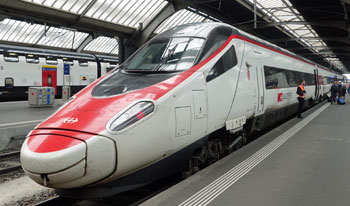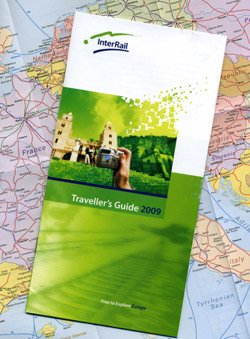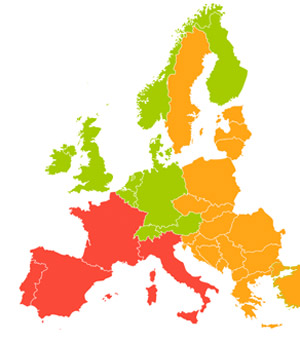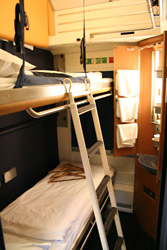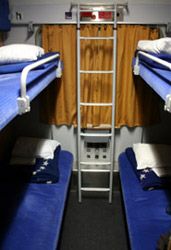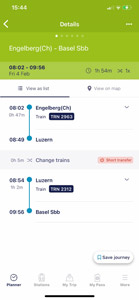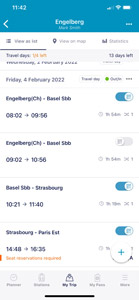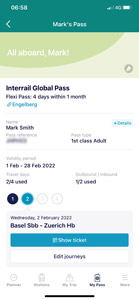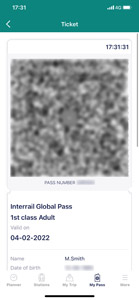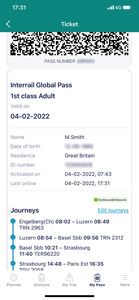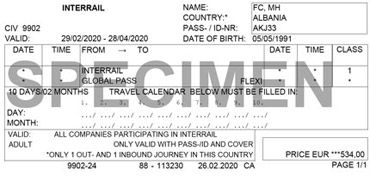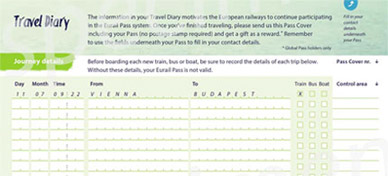|
If you live in the UK, you can buy at www.thetrainline.com/passes Anyone resident in Europe can buy at www.interrail.eu or www.raileurope.com Immediate delivery: After buying a mobile pass you simply load it into the Rail Planner app. More info. Activate any time up to 11 months after buying it.
|
What is an Interrail pass?
Interrail is the railpass range for European residents, giving unlimited train travel on the scheduled train services of the national train operators across most of Europe. It started in 1972 as a railpass for young people, there are now Interrail passes for adults, children youths & seniors, an ideal way to explore Europe at ground level with someone else doing the driving.
![]() Who qualifies for an
Interrail pass?
Who qualifies for an
Interrail pass?
![]() Interrail or point-to-point
tickets?
Interrail or point-to-point
tickets?
![]() How does an
Interrail pass work?
How does an
Interrail pass work?
![]() When do you need a
reservation?
When do you need a
reservation?
![]() Sleepers & couchettes
on overnight trains
Sleepers & couchettes
on overnight trains
![]() Other useful railpasses:
Swiss, Spain
Other useful railpasses:
Swiss, Spain
![]() Train travel in Europe general information
Train travel in Europe general information
![]() Recommended timetables, maps & guidebooks
Recommended timetables, maps & guidebooks
![]() Travel insurance,
mobile data, VPN & other tips
Travel insurance,
mobile data, VPN & other tips
![]() Interrail map showing train routes in the participating countries.
Interrail map showing train routes in the participating countries.
![]() Using an Interrail on Eurostar: How to buy a Eurostar passholder fare
Using an Interrail on Eurostar: How to buy a Eurostar passholder fare
Who qualifies for an Interrail pass?
-
You can buy an Interrail pass if you are a citizen of any of the countries which participate in the Interrail scheme
United Kingdom, Republic of Ireland, France, Spain, Portugal, Switzerland, Italy, Greece, Germany, Austria, Belgium, Netherlands, Lithuania, Luxembourg, Norway, Sweden, Denmark, Finland, Czech Republic, Slovakia, Hungary, Croatia, Slovenia, Bosnia, Poland, Romania, Bulgaria, North Macedonia, Serbia, Turkey.
-
You can also buy an Interrail pass if you can prove that you are legally resident in any of the countries listed above, or in one of the following countries:
Iceland, Albania, Russia, Ukraine, Latvia, Estonia, Moldova, Malta, Cyprus, Morocco, Turkey, Algeria or Tunisia.
Since 2015 you don't need to have lived in one of these countries for over 6 months, it's enough to be legally resident when you buy the pass as long as your residency doesn't expire before the end of the pass validity period.
-
If you live outside these countries, for example in the USA, Canada, India or Australia, you qualify for a Eurail pass instead. But don't worry, Eurail passes are now virtually identical to Interrail passes.
-
You can buy an Interrail pass a maximum of 11 months before the date you want it to start. If you buy a mobile pass to use on your phone, there's no need to specify a start date, you can choose the start date any time in the 11 months after buying it.
-
To qualify for a Youth pass you must be under 28 on the first day of pass validity. The age limit was increased from under 26 in 2017.
Interrail global pass prices
An Interrail Global Pass covers all participating countries, download the map here. Passes are priced in euros, check GBP prices at www.thetrainline.com/passes.
-
Child = aged under 12. Youth = anyone aged under 28 on first day of pass validity. Senior = anyone over 60 on first day of pass validity.
-
Children under 12 get a free pass: Children aged 4-11 (inclusive) qualify for a free Interrail pass when they travel with someone over 18 using a Youth, Adult or Senior pass. Although they still need to pay passholder reservation fees! Maximum 2 children per adult.
Children under 4 travel free anyway in all countries, no pass needed. In some countries the age limit is under 5 or under 6, see a list here.
-
Continuous means that you pick the date you want your Interrail pass to start, and it then gives 15 days, 22 days or 1 calendar month's continuous unlimited travel for the whole of that period.
-
Flexi means that the Interrail lasts for an overall period of either 1 month (for the 4, 5 or 7-day passes) or 2 months (for the 10 & 15-day passes), starting on any date you choose, but you only get 4, 5, 7, 10 or 15 days of unlimited travel within that period. You can 'spend' each day of unlimited travel on any date you like within that 1 or 2 months. They do not have to be consecutive.
-
What countries are covered? The Interrail global pass gives you unlimited train travel throughout Europe, covering the national train operators in Austria, Belgium, Bosnia, Bulgaria, Croatia, Czech Republic, Denmark, Estonia (new from 2020), Finland, France, Germany, Great Britain, Greece, Hungary, Ireland, Italy, Latvia (new from 2020), Lithuania, Luxembourg, Montenegro, Netherlands, North Macedonia, Norway, Poland, Portugal, Romania, Serbia, Slovakia, Slovenia, Spain, Sweden, Switzerland, Turkey. Though you only get limited travel in your own country of residence, as explained here. For more info on what train operators are covered in each country, see the country-by-country list here.
-
Interrail global passes do not cover Russia, Ukraine, Albania, Moldova or Belarus. Morocco dropped out in 2007.
-
Remember to budget for reservation fees: In addition to the pass, you may need to pay for (a) a Eurostar passholder fare from London to Lille, Paris, Brussels or Amsterdam and (b) reservation fees for some trains, especially in Spain, Italy or France, and for sleepers or couchettes. See the advice in the reservations section. How much are they? How do you make them? That's explained on the Interrail reservations page.
One-country pass prices
You can buy one or more Interrail passes covering just one country each. These also come in 1st class adult, 2nd class adult, 1st class child (aged 4-11), 2nd class child (4-11), and 2nd class youth (aged 12-25 inclusive) versions. Prices vary by country, see www.interrail.eu or (if you're in the UK) www.raileurope.com.
How to buy an Interrail pass
|
If you live in the UK, buy at |
|
Anyone resident in Europe can buy at www.interrail.eu or www.raileurope.com |
You can choose either the classic printed card pass sent to you at extra cost, or a mobile pass which which can be downloaded instantly to sit in the Rail Planner app on your phone. The mobile option was introduced in September 2020 and 97% of people now choose a mobile pass.
To buy a Eurostar passholder fare, see the instructions here. To make other reservations, see the reservations guide.
If you choose a mobile pass
-
You download it, delivery is instant and free;
-
You can activate the pass (in other words, choose the date on which you'll start using it) any date you like in the 11 months after buying it. A printed pass arrives with your chosen start date already printed on it, this cannot be changed;
-
You only need to enter your passport number when you activate the pass, so not a problem if your passport is being renewed or you haven't yet got all your companions' passport details;
-
The pass is on your phone so you always have it with you, one less thing to carry around;
-
It's easier to select and add travel diary details on a phone screen than write in biro on a flimsy printed travel diary on a station platform.
-
I've used a mobile pass many times myself, it's easy to use and works well. You need to connect the app to the internet via WiFi or mobile data at least once every 3 days to keep the app updated and the pass valid, but it works offline in between.
If you choose a hard copy pass
-
It's posted to you at extra cost, you need to allow a week or two for delivery;
-
You need to specify the start date when you buy;
-
On the plus side, if your phone runs out of battery you can still show a paper pass (but an Anker powerbank solves this and is a good backup plan for your phone anyway). If you drop your phone and it breaks you can still show a paper pass;
-
You can keep the paper pass as a souvenir afterwards!
Interrail or point-to-point tickets?
-
There's no magic answer!
Why? Because point-to-point train fares vary like air fares, cheap in advance, expensive at short notice or on popular days or dates. Just like flights!
The cost of a pass also varies, depending whether it's adult, senior or youth, and whether it's for a shorter or longer period. Longer period passes are better value as the cost-per-day is lower.
The only way to know for sure is to go online and check current point-to-point prices for each journey you plan to make, add them up and compare with the price of the pass you'd need, factoring in the necessary passholder reservation fees.
See Interrail pass prices & check passholder reservation fees. Check point-to-point prices by selecting the starting city here and I'll tell you which website to use to check fares for that specific route.
But it's not all about price, it's also about flexibility. This example may help:
-
How much is a point-to-point ticket?
Assume you plan to go from Prague to Berlin:
- 18.99 is the cheapest possible advance-purchase fare, price varies like air fares, specified train only, no changes, no refunds.
- 82.50 is the fully-flexible fare which can be bought on the day, unlimited availability, good for any train.
Assume that a few days later you plan to go from Berlin to Amsterdam:
- 37.99 is the cheapest possible advance-purchase fare, price varies like air fares, specified train only, no changes, no refunds.
- 139.99 is the fully-flexible fare which can be bought on the day, unlimited availability, good for any train.
-
How much is an Interrail pass?
If you divide the pass cost by the number of days travel, you get a cost-per-day. The longer the pass duration, the cheaper the cost-per-day:
- 64 per day using a 5-days-in-1-month Interrail global pass (5-day price divided by 5)
- 45 per day using a 10-days-in-2-months Interrail global pass (10-day price divided by 10)
Or if you're aged under 28 and can buy a youth pass:
- 48 per day using a 5-days-in-1-month youth Interrail global pass.
- 34 per day using a 10-days-in-2-months youth Interrail global pass.
A pass gives you unlimited travel, so you can use any train you like, as if you'd bought the fully-flexible ticket. Better, as you could go up & down on trains between Prague & Berlin all day if you wanted, or carry on beyond Berlin to Cologne or Hamburg.
-
So is a pass cheaper?
No, point-to-point advance-purchase tickets are cheaper, it's not a trick question! Prague-Berlin from 18.99, Berlin-Amsterdam from 37.99.
And easiest too, easy to buy online at the German Railways website and show on your phone. Click, click, booked!
So if you're only planning 2, 3 or maybe 4 such trips on fixed dates, your accommodation is pre-booked and you're happy to commit to specific trains 2-3 months in advance on a no-refunds, no-changes basis, then advance-purchase tickets are usually cheapest & easiest.
-
But at short notice or on popular dates, a pass might save money
Remember these are the cheapest possible advance-purchase fares. On your date, prices may be higher, especially at popular times of year. And if you need to go tomorrow or next week so cannot book months in advance, a pass can be cheaper than short-notice point-to-point fares.
-
An Interrail makes sense if you value flexibility
Even when it costs more than advance-purchase tickets, a pass may still make sense because it is flexible. It's significantly cheaper than the fully-flexible fare for most longer-distance journeys.
With an advance-purchase ticket you're nailing your plans to the floor months in advance. Trading up to a pass gives you the freedom to travel when you want, or even decide not to go to Prague after all, but to Vienna instead. An Interrail pass gives unlimited travel all day, so you can make additional journeys the same day, before or after this one.
-
For extensive itineraries, a pass is better
For extensive itineraries, using a stack of advance-purchase point-to-point tickets might be cheaper, but it's risky. If a flood, fire, strike or landslide knocked out one journey, the rest of the trip could come crashing down like a house of cards as advance-purchase tickets become worthless if you miss the train. An Interrail pass gives you the flexibility to re-plan, re-schedule or even re-route as necessary.
Mrs 61 and I once travelled from my in-laws in the Netherlands to Italy using Interrail passes. The day before our return, a train crash in Belgium blocked our planned route, Milan-Paris-Rotterdam. But with our passes we easily re-routed via Milan-Zurich-Cologne-Rotterdam.
-
But avoid using use a pass for short hops
Vienna to Bratislava only costs 11, Florence to Pisa only 9, even bought on the day.
So it'd be cheaper to buy a 4-days-in-1-month pass to cover your longer trips plus a point-to-point ticket for a short hop like this, than to pay an extra 50 for a 5-days-in-1-month pass. Common sense, surely?
-
Remember to factor in the passholder reservation fees
The point-to-point fares you see online include any necessary reservation. If you use a pass, you may have to pay a reservation fee in addition to the cost of the pass. Here's a rule of thumb:
In France, Italy, Spain, reckon on a 10+ reservation fee for every train other than purely local ones, in addition to the cost of the pass.
However, in Benelux, Switzerland, Germany, Austria, Denmark & most of eastern & central Europe, there are usually no fees to pay (unless you want a sleeping berth), you can just board a train, sit in any empty unreserved seat, and show your pass to the conductor. That's a generalisation, but even if a seat reservation is required in these countries it's typically 3 - 5, the same as any other ticket-holder would pay.
The Prague-Berlin & Amsterdam-Berlin examples above usually involve no reservation fee, unless you choose to reserve a seat.
You need to pay a passholder fare to use Eurostar between London & Paris, Lille, Brussels or Amsterdam. This costs 30 in 2nd class or 38 if you have a 1st class pass, see how to use an Interrail pass on Eurostar.
On overnight sleeper trains you need to pay for a sleeping-berth, perhaps 39 for a couchette or 100 for a bed in a 2-bed sleeper.
See a list of Interrail reservation requirements & costs in each country.
Interrail passuser guide & map
Hard-copy Interrail passes usually come with a user guide and a simple European rail map, or download this map here |
|
How does an Interrail pass work?
-
Interrail passes give unlimited travel on national & international trains
An Interrail pass gives unlimited travel on all train services run by the national train operator in the countries it covers - except in your own country of residence, more about that in a minute.
These aren't special 'Interrail trains', these are the normal, regular, scheduled trains, including high-speed trains, sleeper trains, intercity trains, suburban trains & local trains, national & international.
Unlimited means unlimited, as many trains as you like, 1 train or 20 trains, 10 km or 1,000 km.
Interrail passes also cover some private operators and even a few ferry services. The country-by-country guide explains which train operators are covered in each country.
You need to make a reservation for a small fee on some trains, more about this below, and sleeping-berths on night trains also cost extra.
-
Interrail passes don't cover:
Metros, trams or buses in big cities as these are usually run by an urban transit authority;
Some small private local train operators such as Euskotren narrow-gauge trains in Spain (Hendaye to San Sebastian to Bilbao) or the Circumvesuviana railway in Italy (Naples-Pompeii-Sorrento);
A few private inter-city operators who compete with the state-owned national operator on some routes, such as Italo trains in Italy or Ouigo trains in Spain. Nor do they cover lo-cost subsidiaries set up by the national operator such as Ouigo in France or Avlo in Spain. If in doubt, see my country-by-country guide.
-
Flexi & Continuous passes
Continuous passes are valid for a continuous period starting on the date you activate the pass. For example, if you activated a 1-month pass on 10 July, it would give continuous unlimited travel from 00:00 on 10 July until 24:00 on 9 August.
Flexi passes have an overall validity which starts ticking on your first travel day, a date you choose when you activate the pass. You can then spend each of your remaining travel days on any dates you like within that overall validity period.
For example, if you activated a 5-days-in-1-month Interrail pass on 10 July, your first day of unlimited travel would be 10 July, you can then spend each of the remaining 4 days unlimited travel on any dates you like until 9 August, let's say on the 12 July, 17 July, 23 July and 2 August. Or whatever!
Each pass day is good for as many trains, journeys & kilometres as you can cram in from 00:00 to 24:00. In fact, a pass day can cover you beyond midnight if using a sleeper train.
-
You don't get unlimited travel in your home country, just 2 outbound/inbound days
First the bad news: Interrail passes don't give unlimited train travel in your country of residence.
Now the good news: Since 2016 you've been allowed to use a global Interrail pass for one journey in your home country to a border, airport or ferry port at the beginning of your trip and one return journey back home at the end.
These are known as your 2 outbound/inbound days. When using a mobile-type pass, when you add a train in your home country to your pass, it will warn you that you are about to use one of your 2 outbound/inbound days. It shows you how many you have left.
If you live in Britain, Eurostar to/from London counts as a train in your home country, so triggers an inbound/outbound day.
The journey in your home country can involve more than one train, but in principle it should be a continuous single journey between a point of origin (typically your local station) and a border, airport or ferry port. However, the mobile pass doesn't police this, so if (for example) you wanted to pause for an hour or two in London between arriving by Eurostar and taking a domestic train home to Newcastle or wherever that's fine, but you shouldn't abuse it by travelling up & down all over Britain all day, it's intended for travel from & to your home town.
Apart from that, inbound/outbound days work like any other travel day, unlimited mileage & unlimited trains midnight to midnight, you need to record the journey on your pass as normal. If it's a flexi pass, an inbound/outbound day counts as one of your travel days, it's not additional!
If you live in Britain, that first inbound/outbound travel day could cover travel from your home station to London, a Eurostar passholder journey, and an onward train on the Continent, all on one pass day.
For example, if you lived in Dundee you could use the first day on your pass to go from Dundee to Edinburgh, Edinburgh to London, a Eurostar passholder journey from London to Brussels, then Brussels to Cologne, all on one pass day. Bargain!
But you couldn't travel Dundee to London on day 1, stay overnight, take Eurostar London to Brussels on day 2, then use your pass to return Brussels-London-Dundee at the end of your trip, as this would be 3 outbound/inbound days and you're limited to 2. Got it?
For the record, technically your two inbound/outbound days don't have to be the first & last day. You can use them on any two days during the validity of your pass. So if you did want to go Dundee-London on day 1, stay overnight, then go London-Brussels-Cologne on day 2, and were happy buying a normal ticket to return to London & Dundee on your final day, that's OK.
Also for the record, it's not a problem if you want to return to your home country during the validity of your pass, then go off travelling again. Although as you only get 2 inbound/outbound days, you'd need to buy regular tickets to get you out of the country & back on your second trip.
-
You can use Eurostar with a 30 passholder fare
Interrail passes cover Eurostar trains between London and Paris, Brussels, Lille or Calais for a fixed price of 30 in Standard if you have a 2nd class pass or 38 in Plus if you have a 1st class pass, a little more from London to Rotterdam or Amsterdam.
Passholder places are controlled by quota, with fairly wide availability if you book well in advance and reasonable availability even on the day of travel or the day before, although at busy times, days or dates not all trains will have passholder places.
I recommend checking Eurostar availability before buying a pass as availability is limited, I explain how to do that here.
If you have a flexi-type pass, a journey with one of these Eurostar passholder fares requires you to use of your travel days, although of course you can use other trains as well during that day. If you live in Britain, a Eurostar trip counts as travel in your home country.
-
Or take a ferry to mainland Europe
If you prefer to travel by ferry rather than Eurostar, or if all the cheap Eurostar fares have sold out, there's always a ferry! You can buy a Stena Line Rail & Sail ticket from London (or anywhere in East Anglia including Cambridge, Norwich and Peterborough) to Hoek van Holland, from £64 one way or £128 return with or without a railpass, see the Stena Line Rail & Sail page, book online at www.stenaline.co.uk. It's a wonderful way to reach the Continent. There is no longer any Interrail discount on Dover-Calais or Newcastle-Amsterdam ferries.
-
How to find train times for using your Interrail pass
Use the excellent German Railways online timetable at int.bahn.de. It covers pretty much the whole of Europe. Most trains shown in its database can be used with an Interrail pass, although supplements or special fares must be paid on some. I use int.bahn.de all the time!
Or download the Rail Planner app. Go to www.interrail.eu/en/plan-your-trip/rail-planner-app and download the Rail Planner app for your phone (please let me know if that link stops working). This is this a great Europe-wide timetable app which you can use to check train times whilst on the move as the timetable works offline, with no mobile data costs. The app also does passholder reservations for Eurostar, Eurostar (formerly Thalys) & Trenitalia high-speed trains. If you buy an Interrail mobile pass, the pass sits in the Rail Planner app on your mobile.
Personally I trust the 'live' online data of int.bahn.de more than the Rail Planner app's offline data, but Rail Planner will warn you if a train shown in its search results isn't covered by Interrail, which is a plus.
-
What about ferries within Europe, for example to Greece?
An Interrail global pass also gives free travel on Superfast Ferries, Minoan Lines & Blue Star Ferries between Italy (Bari, Brindisi, Ancona or Trieste) and Greece (Corfu, Igoumenitsa or Patras for the train to Athens). Port taxes & a fuel surcharge need to be paid, and cabin berths are extra, so think of it as a reduction, not free travel. Superfast and some other ferry operators also charge a summer supplement. An Interrail pass also gives a significant discount (usually in the region of 30%-50%) on normal fares for some other shipping operators, for example, Silja Line (Stockholm-Helsinki or Stockholm-Turku.
When do you need a reservation?
|
Where do you need reservations? ...an easy rule of thumb |
|
|
|
|
|
Green = Travel freely! Pass-friendly countries, seat reservation usually optional. Yellow = Travel easy! Also pass-friendly, reservation often required, but no big deal, the same 2-5 that any passenger with a full-price ticket pays. Red = All inter-city trains require a special passholder reservation, budget for 10+ a pop. Some international trains to/from France charge 20-40. |
-
The country-by-country reservations guide explains which specific trains require a reservation in each country and roughly how much it costs, but here is my rough - but pretty accurate - rule of thumb.
-
Local, regional & suburban trains
In virtually all countries, you can just hop on any local, regional or suburban train at any time, and show your Interrail pass to the conductor if and when asked. Seat reservation is not even possible. Easy!
-
Pass-friendly countries
Ireland, Netherlands, Belgium, Luxembourg, Switzerland, Germany, Austria, Denmark & most of central & eastern Europe.
In these countries, seat reservation is usually optional even on long-distance trains and there's nothing extra to pay unless you want a reserved seat, or a couchette or sleeper on an overnight train.
You can hop on any train without a reservation, sit in any unreserved empty seat, and show your Interrail pass when asked by the conductor - even premier high-speed trains like Germany's superb ICE or Austria's excellent railjet trains. Trains cannot 'sell out'.
If you want a reserved seat (a sensible move for a long journey to avoid having to stand at busy times) it only costs 3-5. Passes retain their 'hop on, hop off' convenience factor in and between these countries.
There are a few key exceptions: International journeys to or from France do require compulsory reservation with a fee to pay. Eurostar (formerly Thalys) high-speed trains between Brussels & Amsterdam and between Brussels & Cologne have compulsory reservation & a fee for railpass holders. There's a surcharge on railjet & Eurocity trains between Germany/Austria & Italy. A few scenic tourist trains in Switzerland require a seat reservation/supplement, such as the Glacier Express & Bernina Express. Poland, Slovakia, Hungary & Romania require seat reservations on all their inter-city trains, but these are just normal seat reservations costing 1-3, no big deal. All this is explained in the country-by-country guide.
-
Pass unfriendly countries
France, Italy, Spain, Portugal & Sweden
In these countries, inter-city trains are all-reserved like planes. Passholders must pay to make a reservation for every inter-city journey, including international journeys starting or ending in these countries.
Reckon on paying 10+ for every train ride in these countries, sometimes less, sometimes more. On Italian Frecciarossas it's 13. French TGVs it's 10 (limited quota) or 20 when the 10 places sell out. Eurostar (formerly Thalys) Paris-Brussels-Amsterdam is 15-25. TGV-Lyria 30-70, Paris-Milan TGV 31, Paris-Barcelona TGV 34.
-
Is there a quota for passholders?
Usually, no. On 99% of trains/routes/operators, even if there was only one seat left on the train, you'd be entitled to it with your pass. In other words, there's absolutely no disadvantage in using a pass, it's just as good as having a full-flex ticket.
However, in a handful of cases - usually involving France - there are limited places for passholders, so a train can be sold out for passholders but still have seats available for fare-paying customers. Most notably this includes Eurostar to/from London, Paris-Brussels-Amsterdam on Eurostar-formerly-Thalys, Paris-Turin-Milan TGVs & Paris-Barcelona TGVs.
But for most other trains including French domestic TGVs, TGV-Lyria and Spanish or Italian high-speed trains, passholders can always get seats unless the train is physically full, which can happen at Christmas or Easter or on a busy Friday, but you'll usually find places even on the day.
-
Sleeper trains
You need to pay for a sleeper or couchette reservation on overnight trains. Remember that with a flexi type pass, an overnight train only uses one pass day, the date of departure, see the explanation here.
-
See the country-by-country reservations guide to see which trains need a reservation, what it costs and how to make it.
Can you avoid having to reserve?
-
Sometimes you can avoid paying a reservation fee if you don't mind a slower or less comfortable journey. For example, from Rome to Florence there are frequent high-speed Frecciarossa trains with a 13 reservation fee, but also a few fairly fast InterCity trains with only a 3 reservation fee, and some much slower regional trains with no reservation needed. Between Brussels & Amsterdam there are high-speed Eurostar (formerly Thalys) trains taking 1h49 with a 22 fee or hourly EuroCity Direct trains taking 2h08 with no reservation needed. The choice is yours!
-
In other cases avoiding a fee is more trouble than it's worth, as it would mean a relay-race of local trains taking hours longer and involving umpteen changes of train. Just bite the bullet & pay the fee! I'd put Paris-Brussels, Paris-Amsterdam, Paris-Nice, Paris-Italy in this category.
Tip: To see if there is a reasonable no-fee alternative, try using the Europe-wide online timetable at int.bahn.de, but click Mode of transport and select Local transport only.
How do you make reservations?
-
You can make reservations online in advance, or you can make them at stations as you go, it's up to you.
-
For specific advice on which website to use to book a specific train or route, see the Interrail reservations guide.
-
For general advice on how to make passholder reservations, see the How to make reservations section below.
-
To make Eurostar passholder reservations between London and Lille, Paris, Brussels or Amsterdam, see the advice here.
-
Can someone with an Interrail pass travel with someone using a Eurail pass? Yes of course! One of you simply needs to make Interrail/Eurail reservations for 2 people on the trains you want. Because Interrail & Eurail reservations are the same thing, and reservations are entirely separate from your passes.
|
|
|
||
|
2-berth sleeper: A typical 2-berth sleeper, berths made up. More info. |
Couchettes, 4-berth: Much more room than 6-berth! More info. |
Overnight trains
-
What's the difference between a couchette and a sleeper?
Couchettes are basic padded bunks with sheet, rug & pillow, 4 or 6 per compartment, a youth hostel on rails. Sleepers are hotels on rails, with proper beds & washbasin, 1, 2 or 3 beds per compartment. Couchettes & sleepers are explained in more detail here.
-
How much does it cost?
You need to pay a fee to use a couchette or sleeper with your Interrail pass. To give you an idea, here are the passholder supplements for the most common type of sleeper train, a Nightjet. They now vary like air fares, so these are the starting prices:
Seat 14, couchette in 6-berth 34, couchette in 4-berth 44, bed in 3-berth sleeper 54, bed in 2-berth sleeper 74, bed in single-berth sleeper 114, berth in 2-berth deluxe sleeper 94, berth in single-berth deluxe sleeper 134.
Berth fees for specific routes are listed in the Interrail pass reservation guide.
The fee is per person per bed, one ticket = 1 bed. If you are alone and book a single sleeper you get the whole compartment to yourself, if you book a bed in a double sleeper, you get one bed, some other passenger of the same gender gets the other bed and you'll share with them.
Only a 2nd class ticket or pass is needed for all accommodation on Nightjets, even single or double deluxe sleepers. However, in much of eastern Europe, a 1st class pass is necessary to travel in a single-berth sleeper, a 2nd class pass is OK for berths in a double or triple. On Italian domestic sleeper trains a 2nd class pass is all you need to book single, double or triple sleepers or couchettes.
-
Using a pass on a sleeper train
If you have a flexi-type pass, an overnight train only uses one day on your pass, the day of departure. Here is the new rule, this replaced the old 'After 19:00' rule in January 2019:
A Flexi pass day runs from midnight to midnight. But if you board any overnight train before midnight, and do not change trains after midnight, you only need to use one day on a Flexi pass, the day of departure. Got it?
It doesn't matter what time your sleeper train leaves on day 1, or what time it arrives on day 2. The date you enter on your pass is that of day 1.
As normal, you get unlimited travel from midnight to midnight on day 1, so can take other trains on day 1 in addition to the sleeper, all on the same pass day. You can then continue your journey on the direct overnight train until you get off at your destination on day 2. The only proviso is that you cannot change trains after midnight, and that both the departure day and arrival day must fall within the overall pass validity period.
For example, if you wanted to take the Dacia Express leaving Vienna at 19: 42 on the 1st August and arriving Bucharest at 16:06 on the 2nd August, you'd use 1st August as one of your unlimited travel days, this covers the whole of the sleeper journey, even the part on 2nd August - in this example well into in the afternoon.
You'd have unlimited travel all day on 1st August, so it would also cover other journeys that day, for example a preceding journey from Prague to Vienna to connect with the sleeper. On the other hand, if you wanted to take an onward train from Bucharest to Constanta on 2nd August after getting off the sleeper, that means using up another travel day, this time dated 2nd August.
But even if you don't use any other trains on 2nd August, that day of arrival still needs to fall within the overall validity period of your pass, in other words, if you had a 5-days-in-1-month flexi pass the 2nd August must be inside the 1 month period, it cannot be Day 32 just outside it. Got it?
The country-by-country reservations guide explains how to make sleeper or couchette reservations for specific routes.
How to use a mobile pass
-
Mobile Interrail passes were introduced in September 2020 and once you get the hang of it they're really easy to use. The mobile pass sits in the Rail Planner app on your phone, instead of a printed travel diary you use the app's journey planner to select your train and add it to your trip. Then when you actually board that train, you toggle that train onto your pass. The in-app instructions are clear and well-written.
I'll first describe how to use an Interrail mobile pass as a solo traveller. Then if you're a couple, family or small group, I'll explain how to buy & use multiple passes on one phone at the end of this section.
-
Step 1, buy the pass
You can buy an Interrail pass up to 11 months in advance. There's no need to decide on a start date when you buy it, the pass can be activated on any date you choose in the 11 months after purchase. So if your plans change or your trip is postponed, no worries.
-
Step 2, download the Rail Planner app
Get the Rail Planner app for iPhone or Android at www.interrail.eu/en/plan-your-trip/rail-planner-app.
-
Step 3, load your pass into the app
When you buy the pass, you are sent a confirmation email with your pass number. Follow the instructions to load the pass into the Rail Planner app by entering your pass number.
Incidentally, an obvious anti-fraud measure is that you can only load a given pass onto one device at a time. So you can't load one pass onto 10 phones! If you load your pass into your phone and that phone is lost or stolen or you upgrade phones, you can load your pass onto a new phone using your name & pass number, tapping Move pass when prompted and following the steps shown to move the pass to the new device.
-
Step 4, create a trip
The next step is to create a trip and connect your pass to it. Think of a trip as a holding pen, a personal folder in which you can store potential journeys (individual trains or journeys involving multiple trains) found using the app's journey planner that you may or may not end up taking with your pass. You can call the trip anything you like, My Big Interrail Trip, Mark's European Odyssey, Fred, whatever. Your trip lives in the My trip tab on the app. A pass can only be connected to one trip.
-
Step 5, when you're ready to travel, activate your pass
When you know for sure when you want to start using your pass, follow the in-app instructions to activate it, entering your passport number and desired start date. With a flexi-type pass, you choose the date of your first unlimited travel day and the overall validity period (the overall 1 or 2 month period) starts ticking from that date.
Even after doing this, you can still change your mind - you can alter the start date any time until 23:59 the day before, Central European Time. But once the first pass day has started at 00:00 CET, you can't change your mind, that travel day is used.
It safest to activate on the day you want to start using it. One person bought a pass in February, immediately entered a July activation date, forgot about it, postponed his trip to August, then found the pass had already activated and burned through its 1 month validity!
-
Step 6, look up trains in the planner and add them to your trip
Open the app, click on Planner at the bottom and use the journey planner to look up train times. In the search results, find a departure that suits you, click on it for details, then click Save journey to add it to your trip.
You can add as many journeys to your trip as you like, journeys added to a trip are not connected to your pass and there is no obligation to actually take them. As I said, a trip is just your personal library of trains you might be interested in, and you can edit the list at any time.
For example, I wasn't sure if I'd leave Engelberg at 09:02 next morning or finish breakfast early and make the 08:02, so I added both journeys to my trip (which I'd called Engelberg as that's where I was going) to have them both handy, whichever one I ended up taking.
-
Step 7, when you board a train, toggle that train onto your pass
Find the journey in your trip and slide the grey toggle next to it to add it to your pass.
If you now click on My pass you'll see that journey added to your pass, and if you click on Show ticket you'll see all journeys added to the pass for that day listed underneath the QR code. If you make a mistake or change your mind at the last moment, don't worry, you can un-toggle the train to remove it from your pass. It's that simple!
On that Engelberg trip I managed to catch the 08:02, so went to the My trip tab, opened Engelberg and toggled the 08:02 onto my pass. I then swiped left on the 09:02 to delete it from Engelberg - or I could have just left it there, it doesn't matter.
If any of the trains involve travel in your home country, the app will warn you that you're triggering one of your two permitted inbound/outbound days. It keeps a record of those and won't let you have more than two.
Incidentally, toggling a train onto your pass does not in any way 'reserve' or 'book' that train. Reservations are an entirely separate thing. All this does is (a) make the pass valid for that train, it's not a valid ticket until you have done this and (b) act as an electronic travel diary to tell the Interrail management team what trains you've used so they can crunch the numbers and accurately allocate pass revenue to train operators.
-
Step 8, show your pass to the conductor
When a conductor comes along, open the app, click on My pass, pass details appear. Click on Show ticket, the pass QR code appears. The conductor will scan the QR code. Most times, that's it.
Sometimes the conductor will ask you to scroll down from the QR code to the list of journeys which have been added to the pass that day (he's making sure you've correctly added that train to your pass so that the rail operator ultimately gets their share of pass revenue).
Sometimes you'll be asked to show your passport, but not always.
-
How to add a train manually if Rail Planner can't find it
Occasionally, Rail Planner's journey planner can't find a train you want to take, but you can add such journeys manually.
For example, Interrail is valid on the local trains between Latour de Carol & Barcelona, but Rail Planner can't access the database they're listed on. And from Bucharest to Istanbul it thinks there's a change of train in Bulgaria, which in summer in the direct couchette car there isn't.
Simply scroll down to the bottom of the search results and click on the link where it says Can't find your journey? Add it manually to your pass. You can now enter the correct origin, destination, time and (optionally) train number.
-
Troubleshooting
These tips are worth remembering if you have any problems showing your pass:
1. If you click Show ticket and the pass QR code fails to appear, go to My Trip and deselect the train you are using, then toggle it back onto the pass it. Go back to My Pass, click Show ticket again and the QR code may now appear.
2. If that doesn't fix it, or if the app denies that you have a valid pass, don't panic! Put your phone into aeroplane mode, which stops the app trying to contact the server in an area with poor reception. Restart the app and it'll show the pass from it own local data.
-
If you lose or change your phone
If your phone is lost or stolen or you buy a new one, you can transfer your pass to a new device. However, as an anti-fraud measure you can only do this once. More than that and you'd need to contact Interrail/Eurail customer services.
Open the Railplanner app on your new phone and open the Railplanner app. Load the pass using your pass number and surname, just as you did on the original phone. The system will know that the pass is already active on another device. When prompted, select Move pass and follow the instructions. This is not something I've had to do myself, so feedback is appreciated!
-
Buying & using passes for multiple people
You can buy passes for multiple people in one transaction, for example for your family, partner or group of friends. You'll get a separate pass number for each person.
One option is to give each person their own pass number so they can load their own pass on to their own phone and use it independently as explained above. You should use this option if there is any chance that people may want to split up and go off on their own.
The other option is for you to be 'group leader' and manage passes on behalf of everyone, by loading multiple passes onto one phone. Just remember that you won't then be able to split up as all the passes will be one one phone. This cannot be changed afterwards without help from the Interrail Support Team.
The process for handling multiple passes on one phone is a bit clunky, but works. If you try to add a 2nd pass to the same trip, it offers to duplicate the trip. Go ahead and create a duplicate trip for each person in your group and connect their pass to that trip (remember to rename each trip so you know which trip belongs to which person). When you find a train in the journey planner and want to save it to your trip, you are offered tick-box options to save it to multiple trips, so you can save it to everyone's trip at once. When you board the train, you need to open each person's trip and add that journey to that person's pass - unfortunately there's currently no way to do that in one go!
How to use a hard-copy pass
-
The pass: The classic hard-copy Interrail pass is printed on blank ATB-size international train ticket stock with a security background. If it's a flexi-type pass it will have boxes printed on it for each travel day. When you want to use a travel day, you simply write the date in indelible black or blue ink in one of the boxes, using each box in turn.
-
Pass cover number: If you receive your pass stapled inside a paper cover, the pass number is printed on the rear of the cover, not on the pass itself, often referred to as the pass cover number.
-
The travel diary: The pass comes with a blank travel diary. Each time you take a train, you need to write the date, where it's from and where it's to, in black or blue ink. You send it back to them after your trip (free postage) and it's used for market research, it helps allocate Interrail revenue between operators.
Tip: If you use up all the diary pages you can print off more pages at www.eurail.com/content/dam/pdfs/Additional...pdf (please let me know if that link ceases to work!).
-
To make it clear, Brussels to Nuremberg with a change in Frankfurt requires two separate entries, Brussels-Frankfurt and Frankfurt-Nuremberg. However, if a conductor found you had made only one entry, Brussels to Nuremberg, they should point it out (and maybe ask you to change it) but that's all.
-
In theory you could be fined if the conductor finds that you haven't filled in your travel diary, but in practice most conductors will simply ask you to do so if you forgot. However, there's always the risk that you'll meet a jobsworth, so play safe and fill it in while you're waiting for the train or as soon as you get on.
How to make reservations
'Pass' and 'reservations' are totally, utterly, completely separate
-
This often confuses people, so listen up: The process of (1) activating and using your Interrail pass, and (2) making seat or berth reservations on particular trains to go with your pass, are two entirely different, separate, unconnected things. One does not affect the other, in any way at all.
When you find a train in the Rail Planner app, add it to your 'trip' then add it to your pass, this does not reserve seats or 'book' that train in any way whatsoever. All it does is make the pass valid for that journey. It's simply an electronic record that helps Interrail management allocate pass revenue between operators.
Similarly, making a seat or berth reservation on a particular train does not in any way activate your pass or use up a day on your pass or even commit you to using the pass on that train or date. If you have to enter your pass number when reserving, that's only to stop people without a pass making a reservation, it does not affect, trigger or use up your pass. Reservations will not magically show up on your pass or in the Railplanner app, even if you had to enter your pass number when reserving, because your pass and any reservations you make are entirely unconnected, separate things.
The pass itself sits in the Rail Planner app on your phone. A seat or berth reservation (depending how it's made) might be an email with QR code shown on your phone or printed out, or a QR code shown in a train operator's app, or a hard copy ticket from a ticket office. It's not connected to the pass in any way (did I mention that??)
It's just that you need to be in possession of both a pass (properly set up for that train) and a valid reservation before boarding any train which has mandatory reservations. A pass alone is sufficient for most local/regional trains or for trains on which reservation is optional.
-
For example, suppose you live in the UK and have a Interrail pass loaded onto your phone. Your friend lives in Canada and has bought a Eurail pass, loaded onto their phone. Not a problem! The passes don't even need to be activated. One of you can sit at a desktop computer and make passholder reservations for 2 passengers travelling together, entirely unconnected from the passes, following my instructions for reserving that specific train/route/operator in my passholder reservations guide. And if you later decide to bin those reservations and use the passes 3 months later in a totally different country, that's fine! Did I mention passes and reservations are entirely unconnected?
You reserve different trains in different ways!
-
Another reality check: You reserve different trains/routes/operators in different ways, using different websites.
True, there's an Interrail/Eurail reservation service which can reserve many trains, but this can't do all routes/operators and even if it can book a train, there may be alternative methods which are better, either because they avoid the 2 per person booking fee or because they give you extra features such as letting you select seats from a seat map, which the Interrail/Eurail reservation service doesn't.
-
To learn how to reserve specific trains/routes/operators, see my country-by-country Interrail reservations guide.
-
To learn how to reserve Eurostar from London to Paris, Lille, Brussels & Amsterdam, see the Interrail on Eurostar page.
-
For general advice on making reservations, read on...
Option 1, online at the train operator's website
-
Unfortunately, most train operator websites don't sell passholder reservations, only normal tickets. Eurostar, SNCF (French Railways) & Trenitalia used to sell passholder reservations, they all stopped because of abuse by fare-evaders. Renfe (Spanish Railways) never has.
However, there are a few train operator websites that do sell passholder reservations and where possible it's the best way to reserve as you pay no booking fee (only the reservation fee), you get a wide choice of seating options and you can sometimes select seats from a seat map.
-
Operators that can sell reservations on their own websites include:
- DB (German Railways), int.bahn.de can make 'seat-only' bookings for German domestic trains and for international trains between Germany & Amsterdam, Brussels, Prague, Warsaw, Krakow, Copenhagen & Switzerland. You can select your seat from a seat map on German IC or ICE trains. However, do not use it to/from Italy or Paris without first consulting my reservations page as special arrangements apply.
- ΦBB (Austrian Railways), www.oebb.at sells passholder reservations for Nightjet sleeper trains, Nightjet partner sleeper trains, and Vienna-Italy railjet trains. It can also make 'seat only' bookings on reservation optional trains between Austria & Prague, Budapest, Germany or Switzerland. You can select your seat from a seat map on ΦBB's railjet trains.
- SJ (Swedish Railways), www.sj.se sells passholder reservations for Swedish trains, Copenhagen-Stockholm & Stockholm-Oslo trains, and the Stockholm-Hamburg-Berlin sleeper train. You can select your seat from a seat map on many Swedish trains including X2000.
- CD (Czech Railways), www.cd.cz can do 'seat-only' bookings within Czechia and for many international routes to/from Prague. You can usually select your seat from a seat map if the train uses Czech Railways rolling stock.
- PKP Intercity (Polish Railways), www.intercity.pl can sell reservations for trains within Poland and for Berlin-Warsaw & Berlin-Wroclaw-Krakow trains.
Option 2, online using the Interrail reservation service
-
If you can't book direct with the train operator, the next best thing is usually the official Interrail reservations service at www.interrail.eu/en/book-reservations.
You need to buy a pass before you can access this service, as a pass number is required even to run enquiries.
It'll make reservations on most trains in western & central Europe including Eurostar, but not on trains in Great Britain, Ireland, Portugal, Finland, Bulgaria, Greece or Turkey.
Reservations can usually be made until 3 hours before departure, you can use their mobile website if you're already on the move.
There's a booking fee of 2 per reservation in addition to the reservation fee. The prices shown include the booking fee.
One downside, you aren't offered any seating choice, not even 'aisle' or 'window', you basically have to take what the system gives you.
Reservations are usually e-ticketed and emailed to you, in a few cases (for example, Norwegian reservations) hard copy tickets have to be posted to you at extra cost.
-
To learn more about the Eurail reservation service and how to use it, see here.
-
To see whether to use this service for a specific train, go to the reservations page & click on the country where the journey starts.
Option 3, online at other websites
-
Belgian Railways, www.b-europe.com/EN/Booking/Pass
Passholder reservations on Eurostar and Eurostar (formerly Thalys) can be made either at the official Eurail reservation service or at the Belgian Railways international site www.b-europe.com/EN/Booking/Pass (please tell me if this direct link stops working). The advantage of www.b-europe.com/EN/Booking/Pass is that you can check passholder availability before you buy your pass, as the pass number is only needed to buy the reservation, not to run an enquiry. But at the time I write this, b-europe charges a 4 booking fee per total booking, the Eurail reservation service only charges 2 per person.
Tip: If you have a mobile pass and it won't accept your mobile pass number, simply generate a pass cover number from your mobile pass number using this special page: www.eurail.com/en/book-reservations#/generatePassCoverNumber.
-
Rail Europe, www.raileurope.com
The Rail Europe website can sell passholder reservations for many journeys around western Europe including France and Italy. You need to click Add rail pass and select the type of pass you have.
Option 4, by phone with a UK booking agency
-
In many cases, you can't make reservations online, you need to pick up the phone.
-
For trains within France, Spain, Switzerland and between France, Spain and neighbouring countries, call International Rail on 0844 248 248 3 or Trainseurope on 0871 700 7722, office hours Monday-Friday in both cases.
-
For trains in Germany, Austria, central & eastern Europe & Scandinavia, call German Railways UK phone line on 00 49 (0)30 311 68 29 04, lines open 08:30-20:00 Monday-Friday, 09:00-13:00 Saturday & Sunday UK time, 1.5% fee for phone bookings.
Option 5, in person at the station
-
You can make reservations at station ticket offices either in advance or on the day of departure, sometimes up to an hour or two before the train leaves, sometimes right up to departure time. Just show your rail pass at the ticket window and ask for the reservation. Many European railway staff speak some English, but if you don't speak the language, just write down what you want and show it to the booking clerk. Easy!
Other railpasses worth knowing about
Interrail is the main pass range for European residents, but several countries also have their own national railpasses which can be worth knowing about.

 The
European Rail timetable
has train, bus & ferry times for every country in Europe
(eastern and western) plus currency and climate information.
It is definitely worth buying if you're planning an
extensive tour with a Interrail pass - having your own comprehensive
timetable puts you in control of your own trip, and will save you
hours in queues for station information desks or struggling
with station timetables which show only the most basic
information. It costs
around
£15.99 from
www.europeanrailtimetable.eu.
The
European Rail timetable
has train, bus & ferry times for every country in Europe
(eastern and western) plus currency and climate information.
It is definitely worth buying if you're planning an
extensive tour with a Interrail pass - having your own comprehensive
timetable puts you in control of your own trip, and will save you
hours in queues for station information desks or struggling
with station timetables which show only the most basic
information. It costs
around
£15.99 from
www.europeanrailtimetable.eu.
The European Rail Map of Europe is easily the best and most comprehensive map of train routes all over Europe. High speed and scenic routes are highlighted - well worth buying to go with your rail pass! Buy online at www.europeanrailtimetable.eu (with worldwide delivery). There are other maps & even two good European Rail Atlases, see here.
The all-Europe online timetable: You can check train times for almost any European train journey online at int.bahn.de. This is an extremely useful resource for trip planning, provided by the German Railways.
Recommended guidebooks
If you're planning a grand tour, I strongly recommend investing in a Thomas Cook European Timetable for in-depth train information, and the relevant Lonely Planet Guide for in-depth country information on the sights to see, places to stay, places to eat. Alternatively, the Europe by Rail guide combines basic train info with country information.
Click the images to buy online at Amazon.co.uk
Hotels & accommodation
Tips for choosing hotels
Location, location, location: For a night between trains, I'd pick a decent hotel near the station, it simplifies the whole arrival/departure thing. But for a longer stay, I'd want to be close to the sights, for example if we're talking a city like Prague, I'd want a hotel in the old town. That sometimes costs more, but you see more - if you're right there, you can wander out again after dinner, for example. In a cheaper hotel 3 miles out, you probably wouldn't.
Hotels will almost always look after your bags for free if you need to check out and catch an afternoon or evening train, or if you arrive in the morning before you can check in to your room.
|
|
Where to book hotels
Hotels: I normally use www.booking.com to sort my hotels as not only has it got a really good, clear interface, you can usually book accommodation with free cancellation. As trains usually can't be booked more than 90 or sometimes 60 days ahead, this means you can book hotels without any risk months before train bookings open. Any hotel with a review score over 8.0 is unlikely to disappoint.
Hotels will almost always look
after your bags for free if you need to check out and catch an afternoon or
evening train, or if you arrive in the morning before you can check in to
your room.![]()
Backpacker hostels: If you're on a tight budget, don't forget about backpacker hostels. Hostelworld (www.hostelworld.com) offers online booking of cheap private rooms or dorm beds in backpacker hostels in most European cities at rock-bottom prices.
Travel insurance & other tips
Always take out travel insurance
You should take out travel insurance with at least £1m or preferably £5m medical cover from a reliable insurer. It should cover trip cancellation and loss of cash & belongings up to a reasonable limit. These days, check you're covered for covid-19-related issues, and use an insurer whose cover isn't invalidated by well-meant but excessive Foreign Office travel advice against non-essential travel. An annual policy is usually cheapest even for just 2 or 3 trips a year, I have an annual policy with Staysure.co.uk myself. Don't expect travel insurance to bail you out of every missed connection, see the advice on missed connections here. Here are some suggested insurers, I get a little commission if you buy through these links, feedback always welcome.
![]() www.staysure.co.uk
offers enhanced Covid-19 protection and gets 4.7 out of 5 on
Trustpilot.
www.staysure.co.uk
offers enhanced Covid-19 protection and gets 4.7 out of 5 on
Trustpilot.
![]() www.columbusdirect.com is also a well-know brand.
www.columbusdirect.com is also a well-know brand.
![]() If you live in the USA try
Travel Guard USA.
If you live in the USA try
Travel Guard USA.
Get an eSIM with mobile data package
Don't rely on WiFi, download an eSIM with a European mobile data package and stay connected. Most newer mobile phones can download a virtual SIM including iPhone 11 & later, see device compatibility list. There's no need to buy a physical SIM card! Maya.net is a reliable eSIM data retailer with a 4.5 out of 5 Trustpilot rating and a range of packages including unlimited data.
Get a Curve card for foreign travel
Most banks give you a poor exchange rate then add a foreign transaction fee on top. A Curve MasterCard means no foreign transaction fees and gives you the mid-market exchange rate, at least up to a certain limit, £500 per month as I write this. The money you spend on your Curve card goes straight onto one of your existing debit or credit cards. And you can get a Curve card for free.
How it works: 1. Download the Curve app for iPhone or Android. 2. Enter your details & they'll send you a Curve MasterCard - they send to the UK and most European addresses. 3. Link your existing credit & debit cards to the app, you can link up to two cards with the free version of Curve, I link my normal debit card and my normal credit card. 4. Now use the Curve MasterCard to buy things online or in person or take cash from ATMs, exactly like a normal MasterCard. Curve does the currency conversion and puts the balance in your own currency onto whichever debit or credit card is currently selected in the Curve app. You can even change your mind about which card it goes onto, within 14 days of the transaction.
I have a Curve Blue card myself, it means I can buy a coffee on a foreign station on a card without being stung by fees and lousy exchange rates, just by tapping the Curve card on their card reader. The money goes through Curve to my normal debit card and is taken directly from my account (in fact I have the Curve card set up as payment card on Apple Pay on my iPhone, so can double-click my phone, let it do Face ID then tap the reader with the phone - even easier than getting a card out). I get a little commission if you sign up to Curve, but I recommend it here because I think it's great. See details, download the app and get a Curve card, they'll give you £5 cashback through that link.
Get a VPN for safe browsing. Why you need a VPN
When travelling you may use free public WiFi which is often insecure. A VPN encrypts your connection so it's always secure, even on unsecured WiFi. It also means you can select the geographic location of the IP address you browse with, to get around geoblocking which a surprising number of websites apply. See VPNs & why you need one explained. ExpressVPN is a best buy with a 4.7 out of 5 Trustpilot ranking which I use myself - I've signed up as an ExpressVPN affiliate, and if you go with expressvpn.com using this link you should see a special deal, 3 months free with an annual subscription. I also get some commission to help support this site.
Carry an Anker powerbank
Tickets, reservations, hotel bookings and Interrail or Eurail passes are often now held on your mobile phone. You daren't let it run out of power, and you can't always rely on the phone's internal battery or on being near a power outlet. I always carry an Anker powerbank which can recharge my phone several times over. Buy from Amazon.co.uk or buy from Amazon.com.
Touring cities? Use hill walking shoes!
One of the best things I've done is swap my normal shoes for hill-walking shoes, in my case from Scarpa. They're intended for hiking across the Pennines not wandering around Florence, but the support and cushioning for hiking works equally well when you're on your feet all day exploring foreign cities. My feet used to give out first and limit my day, now the rest of me gives up before they do!


